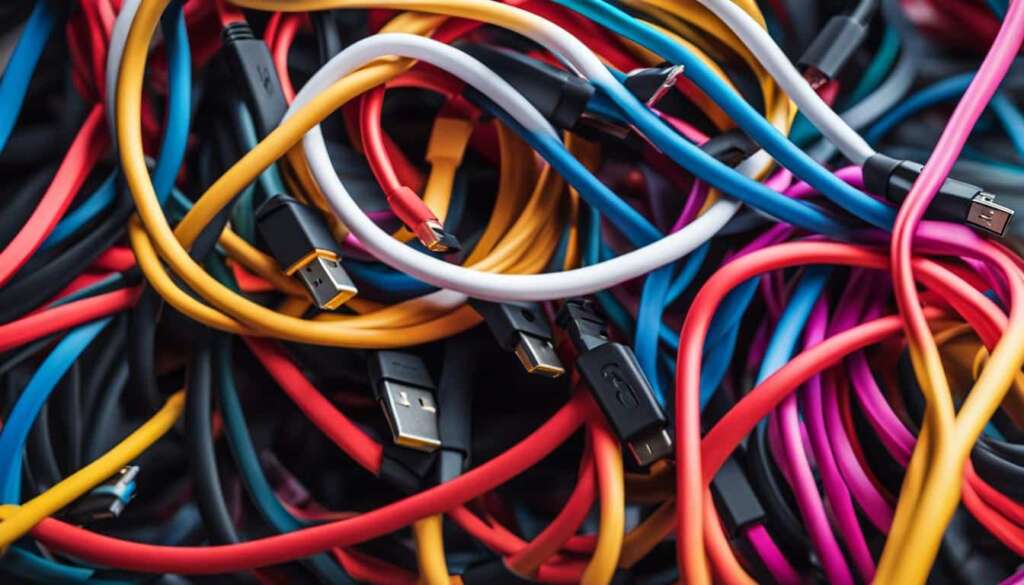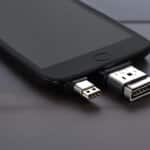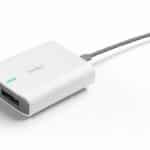Table of Contents
Micro USB is a widely used connector type that plays a crucial role in charging and connecting various devices. Introduced in 2007, micro USBs offer a compact alternative to the traditional rectangular Type A USB connector. With its rounded top and flat bottom, this connector measures approximately 6.85 x 1.8 mm in size.
Micro USB ports can be found on a range of devices, including Android mobile phones, tablets, digital cameras, GPS devices, and video game controllers. These ports facilitate fast data transfer rates of around 480 megabits per second. Additionally, micro USBs are compatible with USB On The Go (USB OTG) functionality, enabling smartphones and tablets to connect to accessories like a mouse, keyboard, or USB flash drive for enhanced productivity.
To ensure seamless connectivity and efficient charging, it is essential to have the appropriate micro USB cables and compatible ports. These cables are designed to transmit both power and data, allowing you to charge your devices while transferring files between them.
Micro USB compatibility is paramount, given its widespread usage. By understanding how micro USB works and its applications, you can make informed decisions when it comes to purchasing and utilizing devices that rely on this connector type.
In the next sections, we will explore the differences between micro USB and mini USB connectors, as well as the emerging USB Type C technology, which is expected to shape the future of connectivity.
Micro USB vs Mini USB: Understanding the Differences
When it comes to USB connectors, two popular options that offer compactness and versatility are micro USB and mini USB. These connector types provide convenient charging and data transfer solutions for a wide range of devices. Let’s explore the differences between micro USB and mini USB to better understand their advantages and disadvantages.
Mini USB: A Brief Overview
Introduced in 2005, mini USB connectors became widely used for various devices, including mp3 players, digital cameras, and older mobile phones. With a 5-pin connector, these ports facilitated data transfer and charging capabilities. However, as technology advanced, mini USB became deprecated, giving way to more advanced connector options such as micro USB and USB Type C.
Micro USB: Enhanced Functionality and Efficiency
Released in 2007, micro USB marked a significant improvement over mini USB in terms of functionality and performance. Similar to mini USB, micro USB also features a 5-pin connector, but its fifth pin, known as the ID pin, offers additional functionality, including support for USB On The Go (USB OTG). This capability enables smartphones and tablets to connect to peripherals like a mouse, keyboard, or USB flash drive, enhancing the overall user experience.
Micro USB connectors are smaller, more durable, and offer faster transfer rates compared to mini USB. With dimensions of approximately 6.85 x 1.8 mm, micro USB ports provide a more compact and streamlined design, making them ideal for modern smartphones, tablets, digital cameras, GPS devices, and video game controllers.
With their smaller size, micro USB connectors are easier to handle and less prone to damage. Moreover, micro USB cables are readily available, making it convenient to find replacements or additional charging options. However, it’s important to note that while micro USB technology is prevalent, some devices may still utilize mini USB ports due to their legacy compatibility.
The Advantages and Disadvantages
Micro USB offers several advantages that make it a popular choice among manufacturers and users:
- Smaller and more compact design
- Enhanced durability
- Faster transfer rates
- Support for USB On The Go functionality
- Wide availability of charging cables
However, there are also a few disadvantages associated with micro USB:
- Limited power delivery capabilities
- Slower data transfer compared to newer connector types
- Ongoing transition to USB Type C, which offers more advanced features
In conclusion, micro USB and mini USB provide compact and versatile connectivity options for various devices. While micro USB offers enhanced functionality and efficiency, mini USB ports are still in use in certain devices. It’s important to consider the specific requirements of your devices when determining the appropriate USB connector type to ensure optimal compatibility and performance.
Micro USB vs USB Type C: A Comparison
USB Type C is a newer USB connector type that is considered the successor to the traditional Type A USB connector. While micro USB is still widely used, USB Type C is gaining popularity and is expected to eventually replace Type A in the future.
USB Type C connectors are smaller and can be plugged in either direction, making them more convenient to use. This eliminates the frustration of trying to insert the cable the “right” way, as both ends are the same. Additionally, USB Type C cables offer faster transfer rates, ranging from 5 to 40 gigabits per second. This means quicker file transfers and reduced waiting time.
Another advantage of USB Type C is its ability to provide more charging power compared to micro USB. USB Type C supports Power Delivery (PD) technology, allowing devices to charge faster and more efficiently. This makes it particularly beneficial for devices with larger batteries, such as laptops and tablets.
However, it’s important to note that micro USB ports are still commonly found on many smartphones and devices. The adoption of USB Type C has been slower than expected, partly due to the widespread use of micro USB and the need for manufacturers to gradually transition to the new standard. Despite the advantages of USB Type C, micro USB remains compatible with a wide range of devices, making it still a reliable choice for charging and connecting your devices.
FAQ
What is Micro USB?
Micro USB is a commonly used connector type that is essential for charging and connecting various devices. It is smaller and more compact than the traditional rectangular Type A USB connector.
What devices use Micro USB connectors?
Micro USB ports are commonly found on Android mobile phones, tablets, digital cameras, GPS devices, and video game controllers.
What are the advantages of Micro USB?
Micro USB connectors have fast data transfer rates, support USB On The Go functionality, and are smaller and more durable compared to older connector types like mini USB.
What is the difference between Micro USB and Mini USB?
The main difference between Micro USB and Mini USB is that Micro USB has a smaller size, faster transfer rates, and supports USB On The Go functionality. While Mini USB technology is considered deprecated, some devices still use mini USB ports.
How does Micro USB compare to USB Type C?
Micro USB is still widely used, but USB Type C is gaining popularity and is expected to eventually replace Type A in the future. USB Type C has faster transfer rates, provides more charging power, and can be plugged in either direction.
Are Micro USB cables compatible with USB Type C ports?
No, Micro USB cables are not compatible with USB Type C ports. They have different connector types and require separate cables.













